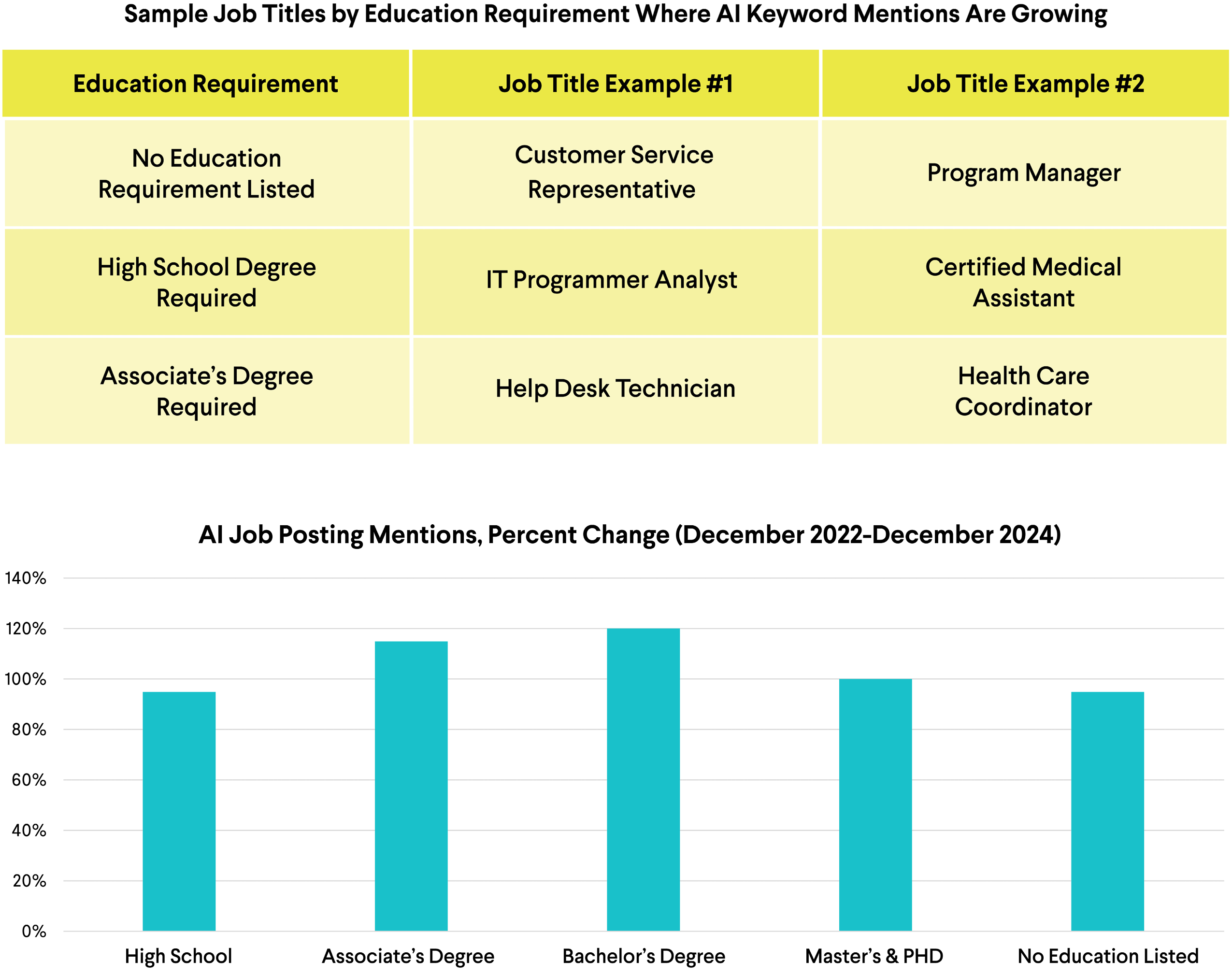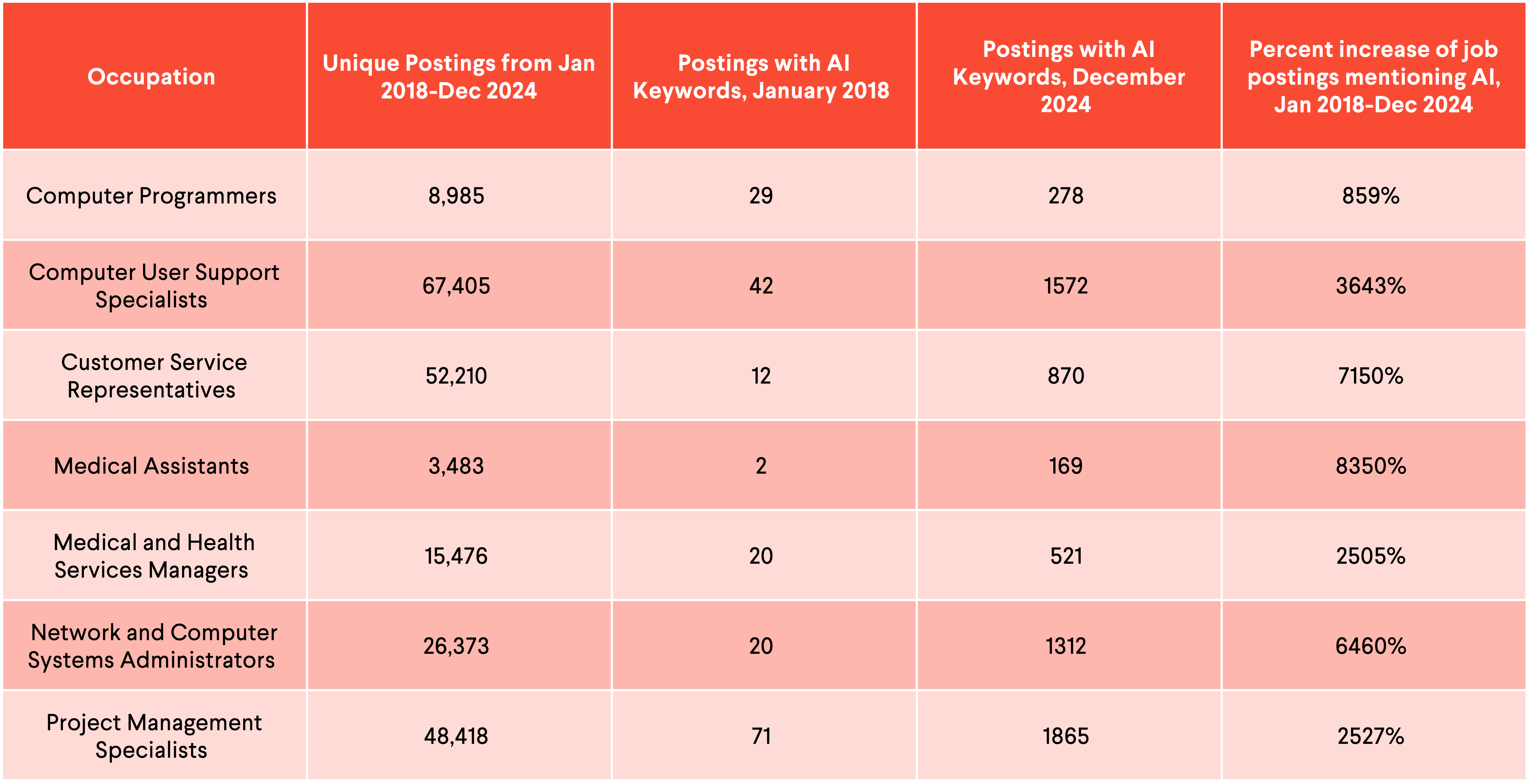
February 6, 2025
At a Glance
In 2023, Jobs for the Future (JFF) released The AI-Ready Workforce, a report that explored how AI might reshape jobs to better understand how to support workers through this transition.
We are still in the very early days of AI’s impact, and we’re just starting to see how it might be affecting the labor market—from job design, to next-generation workforce training, to how businesses are supporting their employees as they adopt new technologies.
At JFF’s Center for Artificial Intelligence & the Future of Work, we believe the transformation set in motion by generative AI is accelerating shifts that will meaningfully change in-demand jobs and skills, with implications for a wide array of stakeholders from training providers and employers to policymakers and investors.
Our new research explores these emerging trends, and offers key insights in three areas:
- Jobs across the economy are increasingly seeking AI skills. We explore this growing demand and share a new skills classification model for in-demand, high-growth occupations accessible to people without a bachelor’s degree. The model finds growing prioritization of generalized professional skills like critical thinking and problem solving, and human skills like initiative, leadership, and communication in tandem with the growth of AI.
- Training providers will need to strengthen their organizational capacity to support learners in an AI-powered future. We interviewed leaders in the field to develop a set of recommendations to support organizational responses to this moment. Download the toolkit here.
- Small businesses are moving toward AI adoption and are eager to drive economic opportunity for both employees and businesses. We conducted a national survey to understand where organizations are in their AI journeys and used these insights to develop a set of human-centered recommendations to support worker-centric AI adoption and talent development strategies. Download the toolkit here.
Policymakers, investors, and funders can contribute to a workforce that welcomes everyone in the age of AI by supporting organizations committed to this work and helping create the conditions that will allow this work to be successful through pathways such as policy development and building the infrastructure for fair digital access. Subscribe for AI updates from JFF to learn more about our ongoing work in this field.
The Fast-Evolving Landscape of Jobs and Skills in the Age of AI
AI and Jobs
Since the public release of ChatGPT at the end of 2022, there has been rapid growth across the economy in job postings mentioning AI. We used keyword searches of job postings for “AI” and/or “artificial intelligence” as a proxy for employers’ growing interest in incorporating AI into roles. We searched for these keywords across all jobs, not just those requiring more specialized AI skills such as machine learning. Demand remains nascent, and these keywords are still rare in job descriptions, but we observed a marked increase when comparing December 2022 to December 2024, with the volume of job postings increasing 108% (from 730,000 job postings in December 2022 to 1.5 million in December 2024.) This suggests a rapid adoption of AI tools over a short time window to support and augment workers’ roles.
Our data show notable demand for AI in job postings in key subsets of the labor market. From an occupational perspective, we see that jobs in the technology sector have had rapid growth in postings with AI keywords—a total of 192,724 postings, for an increase of 407%. We also see high growth in occupations in human resources, where a total of 3,651 postings represented 419% growth; supply chain, where 876 postings showed 86% growth; customer service, where 1,027 postings showed 70% growth; and marketing and public relations, where 4,710 postings showed 38% growth. This data supports emerging trends for where there is noted early AI adoption (McKinsey). Within these concentrations, we see demand across the spectrum of educational requirements.
We see the highest increase of AI mentions in job postings requiring a bachelor’s degree—764,033 total, showing 125% growth in AI mentions since December 2022. However, we also see high levels of growth in roles requiring an associate’s degree (69,050 postings, 114% growth) or a high school degree (90,454 postings, 108% growth) as the highest level of education requirement. Notably, there is also an increase for roles with no education requirement listed (575,339 postings, 95% growth). Note that some roles list multiple education requirements.

AI and Shifting Skillsets
To better understand how the fast but uneven growth of AI may already be reshaping jobs and skills, we conducted a deeper skills analysis for a subset of occupations.
- Network and computer systems administrators
- Computer user support specialists
- Computer programmers
- Customer service representatives
- Project management specialists
- Medical assistants
- Medical and health service managers
We chose these occupations because they are accessible to people without bachelor’s degrees, are in-demand and high-growth, are often connected to several of the industries we studied in The AI-Ready Workforce Report, and are largely representative of jobs that may be disrupted by AI. These occupations represented nearly 6.5 million jobs and 3.7% of the workforce in 2024. And each of these occupations saw immense growth in job postings with AI mentions during our period of analysis of skills demand (see below: Methodology.) For example, medical assistants saw 8,350% growth (from 2 postings mentioning AI in January of 2018 to 169 in December of 2024) and customer service representatives saw 7,150% growth (from 12 postings to 870 for the same time comparison).

Other analyses of AI workforce impacts have discussed changing employer priorities for “hard” or “technical” skills as opposed to “soft” or “durable” skills, but we wanted to dig one level deeper to better understand how demand was changing for specific skills. We found that binary classifications were not nuanced enough, so we leveraged deep dives into existing alternative skills frameworks to further break out skills categories. To better understand how specific skills are becoming impacted, we categorized skills under four classifications.
We split “hard” or “technical” skills into:
Digital Skills
Competencies directly related to the use, management, and development of digital technologies and systems. In current context, these skills range from basic digital literacy to advanced technical proficiencies in software, hardware, and digital platforms. Examples include programming, data analysis, cybersecurity, and proficiency with specific software applications.
- We broke this category out specifically, as new and emerging digital skills may have an especially close relationship with artificial intelligence, given that new digital competencies are likely to be necessary to effectively use the technology, and the technology itself may replace or augment certain existing skill competencies. This gives us a sense of the changes in digital sophistication within different occupations.
Aligned with the European Digital Competence Framework (DigComp) and emphasized in World Economic Forum reports.
Specialized Professional Skills
Domain-specific knowledge and abilities that are particular to an industry, profession, or field of expertise. These skills are often technical in nature but not necessarily digital, and they are crucial for performing tasks unique to a particular domain or sector. Examples include financial modeling for finance professionals, diagnostic techniques for healthcare workers, or specific design software for architects.
Similar to “sector-specific” or “industry-specific skills” in International Labour Organization reports and National Occupational Standards (UK).
And, we split “soft” or “durable” skills into:
Generalized Professional Skills
Professional competencies that are not tied to any particular domain or industry but are essential for effective performance across various job roles and sectors. These skills, while transferrable, are specifically relevant to professional contexts and distinct from general human skills. Examples include project management, strategic planning, business analysis, and professional writing.
Similar to “transversal skills” (OECD) and “transferable skills” (LinkedIn Global Talent Trends).
Human Skills
Personal attributes and interpersonal abilities that enable effective interaction, collaboration, and personal growth. Often referred to as “soft skills,” these competencies are fundamental to human relationships and emotional intelligence in both professional and personal contexts. Examples include communication, teamwork, adaptability, leadership, and problem-solving in interpersonal situations.
Similar to “soft skills” (LinkedIn, World Economic Forum) or “human capabilities” (Deloitte Global Human Capital Trends).
Methodology
We looked at the listed seven occupations and used job posting data in Lightcast to compare demand for the top 20 growing and top 20 declining skills across each of the four skills categories in 2018 (chosen as a baseline year prior to the launch of ChatGPT and subsequent mainstream familiarity with AI) to the demand in 2024 (most recent and available full year of data following the launch of ChatGPT.)
What We Learned
From this analysis we see three emerging themes occurring across these seven occupations in tandem with the growing prominence of AI in the workforce:
1. Specialized digital skills (skills that require advanced expertise) are experiencing high rates of churn as new technologies are introduced and certain once-ubiquitous industry skills are likely being replaced by, or rolled into, new skill sets. In addition, there is a correlation in the labor market data between the rise of AI and the churn seen in the digital skills category. This means that technological advancements, accelerated through AI adoption, are shortening the useful life of some specialized skills and creating challenges for skills training to keep up with this rapid pace of change.
EXAMPLE
For network and systems administrators, cloud solutions and cloud computing are critical and growing specialized digital skills. We see demand for these skills increasing while skills such as distributed computing and database modeling are decreasing. This suggests that skills related to older technologies are gradually being replaced by skills associated with new technologies at an accelerated rate.
2. Professional skills, both specialized and generalized, are continuing to show up consistently in job postings, with nearly the same percentage appearing in 2024 as 2018. This means that, while digital skills are experiencing rapid and uneven turnover, employers are looking for both domain-specific and domain-agnostic professional knowledge in workers.
EXAMPLE
For customer service representatives, we see a continued valuing of professional skills like business operations and project management.
3. Human skills are rapidly and consistently increasing in demand from employers independent of occupation. AI may already be reinforcing a shift in demand for these non-specialized skill sets, even in highly technical roles, suggesting that these human skills are more resilient to displacement by AI.
EXAMPLE
Skills like critical thinking, problem solving, initiative, leadership, and communication were increasingly prioritized across each of these occupations.

